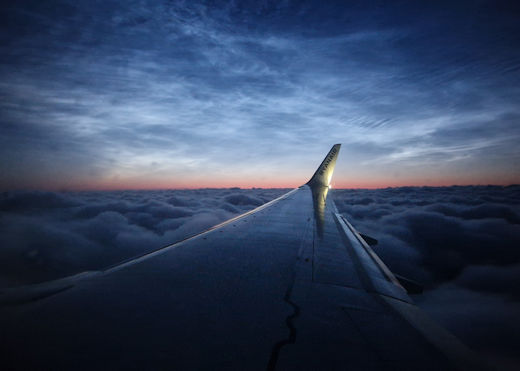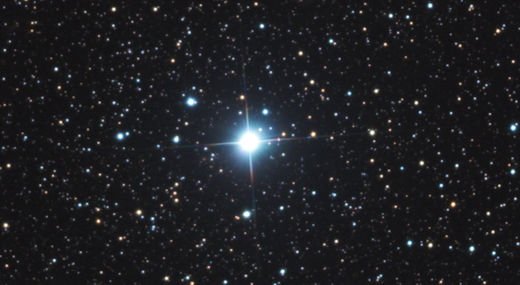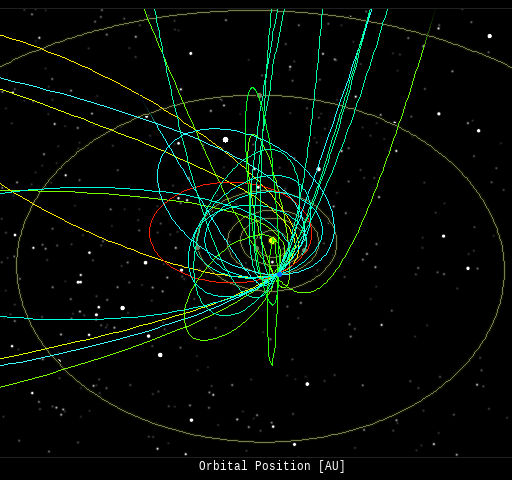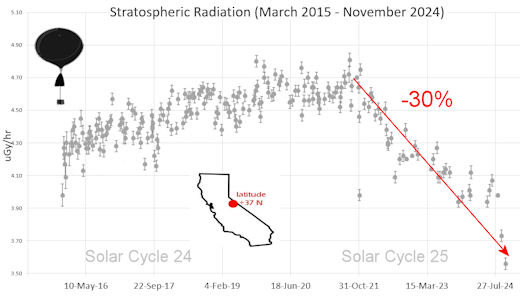This is an AI Free Zone: AI isn't all bad. Large language models are good writers with access to vast stores of data. There's still no substitute for a human being with decades of space weather forecasting experience. This website is 100% human. | | |
A CME IS COMING: But it's not a big one. A minor CME is expected to strike Earth during the late hours of July 1st, according to a NASA model. The CME was hurled into space on June 28th by a C4-class solar flare from sunspot 4126. Even minor CMEs can cause geomagnetic storms, so high-latitude sky watchers may see auroras this week. CME impact alerts: SMS Text
FROSTED METEOR SMOKE: A giant ring of frosted meteor smoke is surrounding the Arctic Circle. Bianka Doman-Mócsány saw it last night from the window seat of an airplane landing in Sweden:

"We had just started our descent to the Gothenburg airport last night when we saw this magnificent display," says Doman-Mócsány. "It was quite an amazing view!"
These are noctilucent clouds (NLCs). They appear every June when summertime wisps of water vapor rise to the edge of space and form rimes of ice around the ash of burned-up meteors. NLCs glow electric-blue in the night sky with fine ripples that distinguish them from ordinary clouds. Look for them after sunset when geometry favors their visibility.
more images: from Peter Paul Hattinga Verschure of Deventer, The Netherlands; from Ian Carstairs of Harleston, Norfolk, UK; from Nigel Wood of Langar, Nottinghamshire, UK
Realtime Noctilucent Cloud Photo Gallery
Free: Spaceweather.com Newsletter
TWO NAKED-EYE NOVA: A person could go a lifetime without seeing a star explode with their own eyes. Right now, people in the southern hemisphere can see two stars exploding at the same time. The first (V462 Lupi) appeared on June 12th in the constellation Lupis, and the second (V572 Velorum) on June 25th in Vela. They're both brighter than 6th magnitude, the threshold for naked-eye visibility.

Eliot Herman photographed V572 Velorum on June 28th using a robotic telescope in Chile.
"This is without question an extremely rare event, if not an historical one," says astronomer Stephen O’Meara, who has been scouring historical records for the last time this happened. "I have yet to find an occurrence of two simultaneous nova appearing at the same time."
"I thought I had found a pair in 1936 (V630 Sgr and V368 Aql)," he says. "But I looked at their light curves, and it turns out they were not at maximum brightness at the same time."
These appear to be "classical novas." First documented by Chinese astronomers some 2000 years ago, the explosions occur in binary star systems. White dwarf stars steal gas from a bloated partner until the stolen fuel ignites in a sudden thermonuclear blast. It's less dramatic than a supernova, but still an awesome blast.
Nova V462 Lupi is currently near magnitude +5.9, while V572 Velorum at +4.8 is the brighter of the two. Southern astronomers, this may not happen again for a loooong time. Submit your photos here.
Realtime Space Weather Photo Gallery
Free: Spaceweather.com Newsletter
GOLDEN SAPPHIRE PENDANT: Are you looking for an unforgettable gift? Consider the Golden Sapphire Space Pendent. On Feb. 20, 2025, the students of Earth to Sky Calculus launched it to the stratosphere onboard a cosmic ray research balloon:

You can have it for $199.95. Engraved with the words "I love you always and forever", this 18K gold-plated sterling silver pendant features a heart-shaped sapphire crystal surrounded by a ring of glittering 5A cubic zirconia nuggets. It is a visually striking premium pendant that makes a once-in-a-lifetime anniversary or birthday gift.
The students are selling space pendants to pay the helium bill for their cosmic ray ballooning program. Each one comes with a greeting card showing the jewelry in flight and telling the story of its trip to the stratosphere and back again.
Far Out Gifts: Earth to Sky Store
All sales support hands-on STEM education
Realtime Aurora Photo Gallery
Free: Spaceweather.com Newsletter
Realtime Noctilucent Cloud Photo Gallery
Free: Spaceweather.com Newsletter
Every night, a network of
NASA all-sky cameras scans the skies above the United States for meteoritic fireballs. Automated software maintained by NASA's Meteoroid Environment Office calculates their orbits, velocity, penetration depth in Earth's atmosphere and many other characteristics. Daily results are presented here on Spaceweather.com.
On Jun 29, 2025, the network reported 11 fireballs.
(10 sporadics, 1 Northern June Aquilid)

In this diagram of the inner solar system, all of the fireball orbits intersect at a single point--Earth. The orbits are color-coded by velocity, from slow (red) to fast (blue). [Larger image] [movies]
Potentially Hazardous Asteroids (
PHAs) are space rocks larger than approximately 100m that can come closer to Earth than 0.05 AU. None of the known PHAs is on a collision course with our planet, although astronomers are finding
new ones all the time.
On June 29, 2025 there were 2349 potentially hazardous asteroids.
 |
Recent & Upcoming Earth-asteroid encounters: | Asteroid | Date(UT) | Miss Distance | Velocity (km/s) | Diameter (m) |
| 2025 MB1 | 2025-Jun-24 | 11.2 LD | 12 | 43 |
| 2025 MS1 | 2025-Jun-24 | 0.8 LD | 6.3 | 4 |
| 2025 ML89 | 2025-Jun-25 | 3 LD | 8.6 | 22 |
| 2025 MP1 | 2025-Jun-25 | 2.7 LD | 5.4 | 17 |
| 2025 MK2 | 2025-Jun-26 | 7.1 LD | 4.7 | 13 |
| 2025 MR89 | 2025-Jun-26 | 5.5 LD | 8.6 | 20 |
| 2025 MT1 | 2025-Jun-27 | 15.5 LD | 2.4 | 20 |
| 2014 DH | 2025-Jun-28 | 17.1 LD | 12.1 | 17 |
| 2025 MZ1 | 2025-Jun-28 | 3.4 LD | 4.6 | 15 |
| 2025 MS88 | 2025-Jun-28 | 4.4 LD | 10.1 | 22 |
| 2025 ML | 2025-Jun-28 | 6.7 LD | 11.7 | 24 |
| 2025 MV88 | 2025-Jun-29 | 9.2 LD | 21.7 | 34 |
| 2025 MW89 | 2025-Jun-30 | 5.5 LD | 4 | 13 |
| 2025 MM | 2025-Jul-01 | 5.4 LD | 10.7 | 39 |
| 2025 MY88 | 2025-Jul-04 | 8.8 LD | 8.6 | 36 |
| 2025 MV89 | 2025-Jul-04 | 5.1 LD | 8.7 | 40 |
| 2025 MN88 | 2025-Jul-06 | 1.9 LD | 7.8 | 21 |
| 2025 MO | 2025-Jul-07 | 6.7 LD | 4.6 | 10 |
| 2019 JM | 2025-Jul-09 | 16.6 LD | 6.9 | 14 |
| 2019 NW5 | 2025-Jul-09 | 15.2 LD | 16.5 | 65 |
| 2025 MD89 | 2025-Jul-11 | 14.7 LD | 8 | 38 |
| 2005 VO5 | 2025-Jul-11 | 15.9 LD | 14.4 | 382 |
| 2025 MD1 | 2025-Jul-11 | 18 LD | 8.9 | 45 |
| 2025 MG1 | 2025-Jul-12 | 13.2 LD | 7.2 | 42 |
| 2025 MA90 | 2025-Jul-15 | 17 LD | 9.1 | 86 |
| 2022 YS5 | 2025-Jul-17 | 17.4 LD | 6.1 | 38 |
| 2018 BY6 | 2025-Jul-19 | 13.7 LD | 7.4 | 69 |
| 2019 CO1 | 2025-Aug-08 | 17.8 LD | 10.5 | 65 |
| 2022 QB1 | 2025-Aug-10 | 8.9 LD | 3.9 | 6 |
| 2021 PJ1 | 2025-Aug-15 | 4.4 LD | 9.3 | 24 |
| 2025 CO3 | 2025-Aug-16 | 19.8 LD | 8.4 | 90 |
| 1997 QK1 | 2025-Aug-20 | 7.9 LD | 9.8 | 322 |
| 2022 QD3 | 2025-Aug-21 | 15 LD | 6.9 | 35 |
| 2023 PX | 2025-Aug-22 | 2.4 LD | 8.3 | 23 |
| 2019 QQ6 | 2025-Aug-24 | 9.4 LD | 17.2 | 31 |
Notes: LD means "Lunar Distance." 1 LD = 384,401 km, the distance between Earth and the Moon. 1 LD also equals 0.00256 AU. | | Cosmic Rays in the Atmosphere |
SPACE WEATHER BALLOON DATA: Almost once a week, Spaceweather.com and the students of Earth to Sky Calculus fly space weather balloons to the stratosphere over California. These balloons are equipped with sensors that detect secondary cosmic rays, a form of radiation from space that can penetrate all the way down to Earth's surface. Our monitoring program has been underway without interruption for 10 years, resulting in a unique dataset of in situ atmospheric measurements.
Latest results (Nov. 2024): Atmospheric radiation is sharply decreasing in 2024. Our latest measurements in November registered a 10-year low:

What's going on? Ironically, the radiation drop is caused by increasing solar activity. Solar Cycle 25 has roared to life faster than forecasters expected. The sun's strengthening and increasingly tangled magnetic field repels cosmic rays from deep space. In addition, solar coronal mass ejections (CMEs) sweep aside cosmic rays, causing sharp reductions called "Forbush Decreases." The two effects blend together to bring daily radiation levels down.
.Who cares? Cosmic rays are a surprisingly "down to Earth" form of space weather. They can alter the chemistry of the atmosphere, trigger lightning, and penetrate commercial airplanes. According to a study from the Harvard T.H. Chan school of public health, crews of aircraft have higher rates of cancer than the general population. The researchers listed cosmic rays, irregular sleep habits, and chemical contaminants as leading risk factors. A number of controversial studies (#1, #2, #3, #4) go even further, linking cosmic rays with cardiac arrhythmias and sudden cardiac death.
Technical notes: The radiation sensors onboard our helium balloons detect X-rays and gamma-rays in the energy range 10 keV to 20 MeV. These energies span the range of medical X-ray machines and airport security scanners.
Data points in the graph labeled "Stratospheric Radiation" correspond to the peak of the Regener-Pfotzer maximum, which lies about 67,000 feet above central California. When cosmic rays crash into Earth's atmosphere, they produce a spray of secondary particles that is most intense at the entrance to the stratosphere. Physicists Eric Regener and Georg Pfotzer discovered the maximum using balloons in the 1930s and it is what we are measuring today.
| | The official U.S. government space weather bureau |
| | The first place to look for information about sundogs, pillars, rainbows and related phenomena. |
| | Researchers call it a "Hubble for the sun." SDO is the most advanced solar observatory ever. |
| | 3D views of the sun from NASA's Solar and Terrestrial Relations Observatory |
| | Realtime and archival images of the Sun from SOHO. |
| | information about sunspots based on the latest NOAA/USAF Active Region Summary |
| | current counts of failed and deployed Starlink satellites from Jonathan's Space Page. See also, all satellite statistics. |
| | Authoritative predictions of space junk and satellite re-entries |
| | from the NOAA Space Environment Center |
| | fun to read, but should be taken with a grain of salt! Forecasts looking ahead more than a few days are often wrong. |
| | from the NOAA Space Environment Center |
| | the underlying science of space weather |
 | Got a chipped or cracked windshield that prevents you from seeing space weather events while driving? Get windshield replacement from SR Windows & Glass with free mobile auto glass service anywhere in the Phoenix area. |
 | BestCSGOGambling is the best site for everything related to CSGO gambling on the web |
| | These links help Spaceweather.com stay online. Thank you to our supporters! |
| | | | | | |

